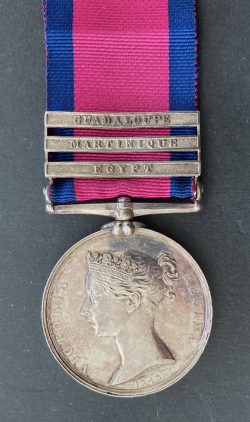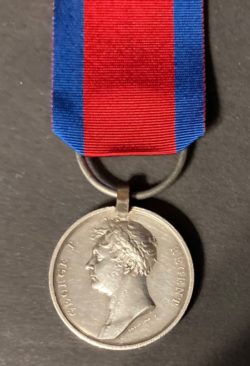M.G.S. A particularly rare combination of Egypt, Martinique, Guadaloupe, 13th Foot, also served in the War of 1812
£2,600.00
Out of stock
M.G.S. 3 clasps, Egypt, Martinique, Guadaloupe,
Andrew Howley, 13th Foot, also served in the War of 1812
Gray Collection, 1916, Glen. 1925
At the landings at Alexandria on 23rd of February, 1801, the 13th landed during the action, and the French were driven from
their position, with the loss of three hundred men, eight pieces of cannon, and many horses. Advancing towards Alexandria, the troops arrived, on the 12th of March, at the vicinity of Mandora Tower, and on the succeeding day attacked the enemy on
the ridge of heights in front. The French were driven from their position. The regiment had 130 in killed and wounded
During the War of 1812, the regiment , arrived on the 28th of June, 1813 at Quebec, and proceeded from thence in steam-boats and bateaux to Montreal. At this period, a numerous American force had penetrated Upper Canada; and a small expedition was fitted out on Lake Champlain, with the view of calling the attention of the Americans to the defence of their own settlements on the borders of that sheet of water. The 13th crossed the river St. Lawrence in boats, on the 24th and 25th of July, and proceeded to the Isle aux Noix, where an expedition was assembled under Lieut.-Colonel J. Murray; Lieut.-Colonel William Williams, of the Thirteenth, being second in command. Sailing from the Isle aux Noix in boats, the expedition navigated the lake, and as it approached the enemy’s post at Plattsburg, the American militia abandoned the place. The British landed, destroyed the arsenal, block-house, commissary’s buildings and stores, with the barracks at Saranac
1814
Active operations were continued during the winter, when the weather permitted; and in the spring of 1814, Lieut.-Colonel Williams, of the Thirteenth foot, had charge of the advance-posts on the river Richelieu.
The American commander, Major-General Wilkinson, concentrated a considerable force for the invasion of Lower Canada; the Thirteenth and forty-ninth regiments, the Canadian voltigeurs, a troop of the nineteenth light dragoons, and a field train, were assembled at St. John’s, and its vicinity, to oppose the invaders. This force was placed under the orders of Colonel Sir Sidney Beckwith, and it was ordered to dislodge a body of Americans, who had taken post at Philipsburg, in the seigniory of St. Armand; but the enemy made a precipitate retreat across the ice on Lake Champlain.
On the 30th of March, the American light troops entered Odell-town, followed by three brigades of infantry, a squadron of cavalry, and eleven guns; they drove in the British piquets, and attached the post at Burton Ville; but were driven back. Their leading brigades afterwards attacked the mill and block-house on the La Cole river, where a detachment of the Thirteenth foot and a party of Canadians were stationed, under Major Handcock, of the Thirteenth. The Americans drove in the piquet, gained possession of a wood, established a battery among the trees, and opened a sharp fire upon the post, which was gallantly defended. Major Handcock having ascertained that the flank companies of the Thirteenth had arrived at the mill, directed an effort to be made to capture the American artillery, when Captain Ellard led his company to the charge with distinguished bravery, and a spirited attempt was made on the battery but withdrew from the unequal contest. The Americans persevering in the attack, a second attempt was made to capture their guns. The post was, however, successfully defended; every attempt of the Americans to capture it was repelled, and they retired, after sustaining considerable loss.
The regiment had thirteen rank and file killed; two officers, two serjeants, and forty-six rank and file wounded.
With copy discharge papers














